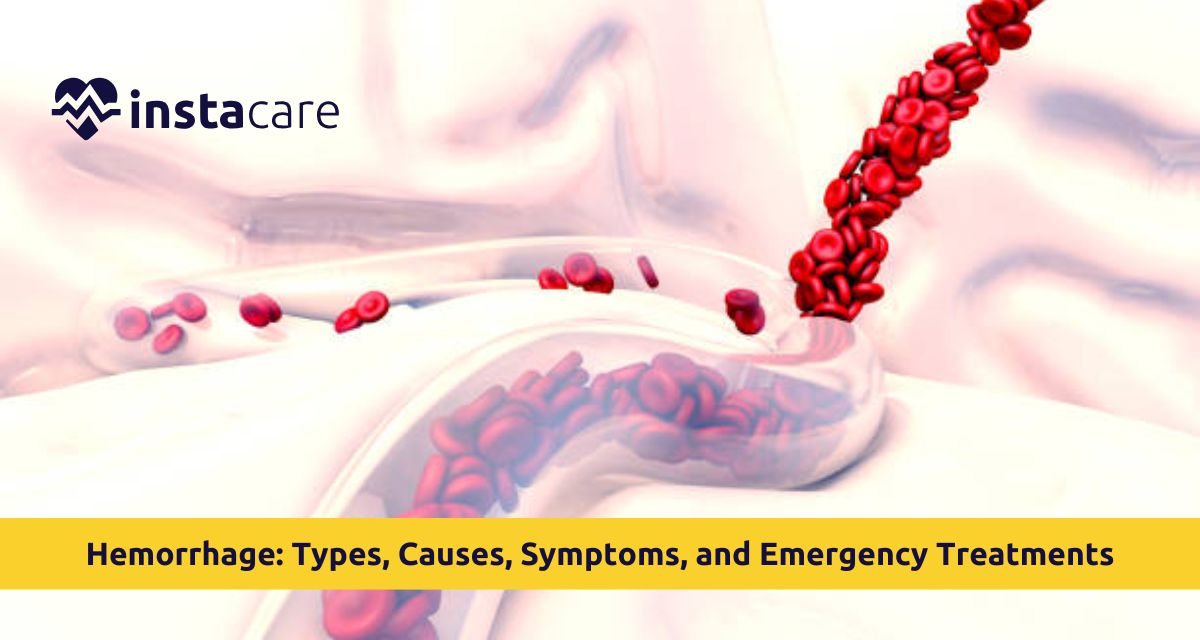Hemorrhage or bleeding is a medical condition where blood in the circulatory system leaks through an injured blood vessel. Bleeding takes place outside or within the body and can either be life-threatening or not necessarily life-threatening. Hemorrhage can happen within most organs and systems depending on where it happens and thus immediate diagnosis and immediate treatment should be assured in trying to survive.
Understanding what is hemorrhage, causes, symptoms, types, and emergency care can be a lifesaver. Due to trauma, disease, or complications of delivery, controlling hemorrhage and the severe bleeding as soon as possible may be a matter of life or death.
What is a Hemorrhage?
In technical terms, it is any uncontrolled or excessive discharge of blood. Hemorrhage is neither a disease nor an etiology but a sign or result of the underlying cause such as internal disease, vessel rupture, or injury.
Level of hemorrhage refers to grading on the basis of:
- Quantity of blood lost
- Rate of blood loss
- Site and source
Mild bleeding can be due to cut or a nosebleed, whereas life-threatening bleeding can be due to rupture of large arteries or organs. Hemorrhage can be external (overt) or internal (ocult except by imaging or signs).
Types of Hemorrhage
Hemorrhages can be classified by etiology and site of bleeding. The frequent types are:
Internal Hemorrhage
Internal hemorrhage is bleeding into cavities or body tissues. It is extremely dangerous since symptoms tend to conceal themselves until death by blood loss becomes apparent. Bleeding in the abdominal cavity, lungs, or brain are some examples.
External Hemorrhage
External hemorrhage is easily visible since blood oozes out due to a tear or cut in the body. It results from cut, trauma, or surgery in the skin surface. External hemorrhage will most likely be easier to notice and treat compared to internal bleeding.
Brain Hemorrhage
Brain hemorrhage is caused by brain vessel disruption and intracranial bleeding. It can be due to head injury,
hypertension, or aneurysm. It is an emergent condition and can result in permanent damage to the brain.
Subarachnoid Hemorrhage
Subarachnoid hemorrhage is another sudden form of brain bleeding between the covering and the brain. Rupture of an aneurysm is most likely to bring it on, and it's an extremely bad and sudden headache that's "the worst headache of my life."
Hemorrhagic Stroke
Hemorrhagic stroke is where one has a break of an intracranial artery and it spurts into the brain tissue. It accounts for approximately 15% of all strokes but has a huge percentage of stroke deaths because it's that awful.
Postpartum Hemorrhage
Postpartum hemorrhage is bleeding that is not controlled during or after the delivery of a baby. It's one of the top reasons for death in women worldwide and either can be directly after giving birth to a baby or weeks after giving birth to a baby.
Gastrointestinal Hemorrhage
A hemorrhage of the stomach or intestine is a gastrointestinal hemorrhage, and it will manifest as blood in vomit or stool. Its cause is liver disease, cancer, or ulcers. It is either severe, life-threatening, or mild.
Some of the Causes of Hemorrhage
There is this huge list of causes of hemorrhage, and they vary according to where and how the bleeding takes place. Some of them are best described as follows:
- Trauma or injury: Accident, falls, and injury will certainly result in blood vessel burst.
- Hypertension: Brain or internal hemorrhage arterial wall heterogenization.
- Aneurysms: Blood vessel distension with tendency to burst.
- Surgical complications: Operation of the big vessels, leading to hemorrhage.
- Blood disorders: Hemophilia negates blood clotting.
- Cancer: Tumors invade and burst nearby vessels.
- Ulcers or gastrointestinal disease: Digestive tract lining destructive.
- Ectopic pregnancy or delivery: Can lead to reproductive tract bleeding.
Hemorrhage vs hematomacan be used. Hemorrhage refers to continued bleeding, whereas hematoma refers to blood accumulation in one spot, usually clotted, more likely to be the cause of a slow or old bleed.
Some Signs of Hemorrhage
Prompt treatment relies on identification of hemorrhage signs. The signs of hemorrhage can be diverse in location and severity of the bleeding but are typically characterized by:
- Sudden or copious bleeding (externally)
- Bruising or swelling (internally)
- Increased rapid pulse and low blood pressure
- Cold, clammy skin or excess sweating
- Dizziness or syncope
- Shortness of breath
- Thready pulse
- Pale color or cyanosis (blue coloring)
These hemorrhage symptoms are an immediate medical emergency. Otherwise, shock, organ failure, or death result from hemorrhage loss.
Severe Hemorrhage Treatments
Hemorrhage treatment depends upon the severity of the bleeding and the type of the bleeding. The following are the primary procedures:
Emergency First Aid
- Apply pressure to the bleeding wounds from the outside with a clean cloth or bandage.
- Place the bleeding spot above the heart level, if possible.
- Use tourniquet in only severe cases if trained.
- Do not try to remove embedded objects, leave them alone until professionals arrive.
Medical Stabilization
- IV fluids and blood to preserve blood volume.
- Oxygen therapy to prevent hypoxia.
- Medications like vasopressors, clotting factors, or antifibrinolytics.
- Instant imaging (ultrasound, CT) to detect internal bleeding.
Surgical and Interventional Methods
Emergency surgery to repair:
- Damaged vessels
- Damaged organs
- Endoscopy to control bleeding in the intestine.
- Craniotomy to control bleeding within the brain.
- Embolisation, a nonoperative procedure to block the bleeding artery.
Early diagnosis and treatment are most important in the management of hemorrhage, particularly interior or life-threatening hemorrhage.
Preventive Hemorrhage Measures
No hemorrhages are preventable, but some things markedly decrease the risk:
- Control of high blood pressure: The chief precipitating cause of hemorrhagic stroke and brain hemorrhage.
- Prompt treatment of peptic ulcer: Prevents gastrointestinal hemorrhage.
- Protective gear: Helmets, seat belts, and head protection helmets prevent trauma injury.
- Stricter control of drugs: Anticoagulants (thinning of blood) need to be taken under stricter control.
- Regular prenatal care: Prevents postpartum hemorrhage and delivery complications.
- Drink well, eat well: Keeps vessels intact and clotting facility intact.
- Treatment of the cause of hemorrhage: i.e., tumor, liver failure, or bleeding disorders.
Education and knowledge is a very important preventatory step against both minor and major hemorrhages.
Conclusion
Hemorrhage is not just "bleeding" it's an unexpected medical occurrence which, if left untreated, will result in instant death. From the cuts to fatal internal bleeding such as subarachnoid hemorrhage, the outcome is catastrophic when the bleeding is not stemmed. Understanding signs, identifying when to summon help, and using efficient protocols in treating hemorrhage can be a matter of life and death literally.
Whether learning first aid treatment or catching a disease that will bleed even further, it is extremely important to know about the entire spectrum of hemorrhage causes and its control. A majority of the hemorrhagic emergent disease can be treated very effectively by the intervention and prevention in the initial stage.
Please book an appointment with the
Best Hematologist in Lahore, Karachi, Islamabad, and all major cities of Pakistan through
InstaCare, or call our helpline at 03171777509 to find a verified doctor for your disease.

